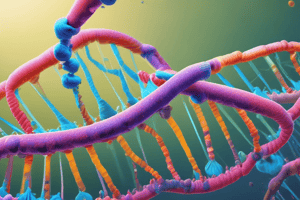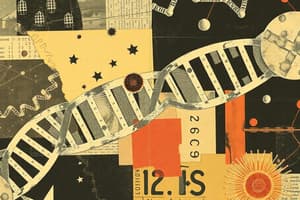Podcast
Questions and Answers
What is the molecule that stores genetic information?
What is the molecule that stores genetic information?
DNA
What is the structure made of tightly packed DNA and proteins that contains many genes?
What is the structure made of tightly packed DNA and proteins that contains many genes?
Chromosome
What type of RNA carries the genetic code from DNA in the nucleus to the ribosome in the cytoplasm?
What type of RNA carries the genetic code from DNA in the nucleus to the ribosome in the cytoplasm?
mRNA (messenger RNA)
What type of RNA brings amino acids to the ribosome during translation?
What type of RNA brings amino acids to the ribosome during translation?
What is the process of copying genetic information from DNA to mRNA called?
What is the process of copying genetic information from DNA to mRNA called?
What is the process of translating mRNA into proteins called?
What is the process of translating mRNA into proteins called?
What is a segment of DNA that provides instructions to make a specific protein or determine a particular trait?
What is a segment of DNA that provides instructions to make a specific protein or determine a particular trait?
What is the complete set of an organism's DNA, including all its genes and non-coding sequences?
What is the complete set of an organism's DNA, including all its genes and non-coding sequences?
What is the genetic makeup of an organism?
What is the genetic makeup of an organism?
What is a version of a gene that codes for specific traits?
What is a version of a gene that codes for specific traits?
What does it mean for an organism to be homozygous for a particular gene?
What does it mean for an organism to be homozygous for a particular gene?
What is an organism that makes its own food?
What is an organism that makes its own food?
What is an organism that cannot make its own food and consumes other organisms?
What is an organism that cannot make its own food and consumes other organisms?
What are proteins that help pack and organize DNA into chromosomes?
What are proteins that help pack and organize DNA into chromosomes?
What does it mean for a cell to be haploid?
What does it mean for a cell to be haploid?
What is the organelle responsible for producing energy for the cell by breaking down glucose and oxygen during cellular respiration?
What is the organelle responsible for producing energy for the cell by breaking down glucose and oxygen during cellular respiration?
What is the enzyme that helps copy DNA during replication, ensuring accuracy for cell division?
What is the enzyme that helps copy DNA during replication, ensuring accuracy for cell division?
What is the enzyme that creates RNA from a DNA template, and what is its role in the cell?
What is the enzyme that creates RNA from a DNA template, and what is its role in the cell?
What is a homolog in genetics?
What is a homolog in genetics?
What is a fertilized egg called?
What is a fertilized egg called?
What is the process of cell division that produces four unique gametes?
What is the process of cell division that produces four unique gametes?
What is the process of cell division that produces two identical cells?
What is the process of cell division that produces two identical cells?
What is the cell's control center where DNA is stored?
What is the cell's control center where DNA is stored?
What is a small structure in the cell that builds proteins by reading mRNA and linking amino acids together during translation?
What is a small structure in the cell that builds proteins by reading mRNA and linking amino acids together during translation?
What is an allele that always shows its trait if one copy is present?
What is an allele that always shows its trait if one copy is present?
What is an allele that only shows its trait if two copies are present?
What is an allele that only shows its trait if two copies are present?
What is the process during meiosis where DNA is exchanged between homologous chromosomes, creating new combinations of genes?
What is the process during meiosis where DNA is exchanged between homologous chromosomes, creating new combinations of genes?
DNA is a double helix.
DNA is a double helix.
Chromosomes are located in the cytoplasm.
Chromosomes are located in the cytoplasm.
MRNA is a type of protein.
MRNA is a type of protein.
TRNA carries genetic information from DNA to ribosomes.
TRNA carries genetic information from DNA to ribosomes.
Transcription occurs in the cytoplasm.
Transcription occurs in the cytoplasm.
Translation is the process of copying DNA to RNA.
Translation is the process of copying DNA to RNA.
A gene is a sequence of RNA that codes for a specific protein.
A gene is a sequence of RNA that codes for a specific protein.
The genome is the complete set of an organism's RNA.
The genome is the complete set of an organism's RNA.
Genotype describes the physical traits of an organism.
Genotype describes the physical traits of an organism.
An allele is a specific version of a gene.
An allele is a specific version of a gene.
A homozygous individual has two different alleles for a gene.
A homozygous individual has two different alleles for a gene.
Autotrophs cannot make their own food.
Autotrophs cannot make their own food.
Heterotrophs are also known as producers.
Heterotrophs are also known as producers.
Histones are molecules of DNA.
Histones are molecules of DNA.
Haploid cells have two sets of chromosomes.
Haploid cells have two sets of chromosomes.
Most body cells are haploid.
Most body cells are haploid.
Mitochondria are the 'powerhouses' of the cell.
Mitochondria are the 'powerhouses' of the cell.
DNA polymerase is involved in the process of transcription.
DNA polymerase is involved in the process of transcription.
RNA polymerase creates DNA from an RNA template.
RNA polymerase creates DNA from an RNA template.
Homologs are genes that evolved from a common ancestor.
Homologs are genes that evolved from a common ancestor.
A zygote is a fertilized egg.
A zygote is a fertilized egg.
Meiosis results in the production of four identical daughter cells.
Meiosis results in the production of four identical daughter cells.
Mitosis is a type of cell division that produces haploid cells.
Mitosis is a type of cell division that produces haploid cells.
The nucleus is the control center of the cell where ribosomes are stored.
The nucleus is the control center of the cell where ribosomes are stored.
A ribosome is a small structure in the cell responsible for building proteins.
A ribosome is a small structure in the cell responsible for building proteins.
A dominant allele masks the expression of a recessive allele.
A dominant allele masks the expression of a recessive allele.
A recessive allele only expresses its trait if two copies are present.
A recessive allele only expresses its trait if two copies are present.
Genetic recombination is a process that reduces genetic diversity in offspring.
Genetic recombination is a process that reduces genetic diversity in offspring.
Flashcards
DNA
DNA
Molecule that stores genetic info
Chromosome
Chromosome
Structure made of tightly packed DNA and proteins that contains many genes. Found in the nucleus, chromosomes organize and store genetic information.
mRNA (messenger RNA)
mRNA (messenger RNA)
Type of RNA that carries the genetic code from DNA in the nucleus to the ribosome in the cytoplasm, where proteins are made.
tRNA (transfer RNA)
tRNA (transfer RNA)
Signup and view all the flashcards
Transcription
Transcription
Signup and view all the flashcards
Translation
Translation
Signup and view all the flashcards
Gene
Gene
Signup and view all the flashcards
Genome
Genome
Signup and view all the flashcards
Genotype
Genotype
Signup and view all the flashcards
Allele
Allele
Signup and view all the flashcards
Homozygous
Homozygous
Signup and view all the flashcards
Heterozygous
Heterozygous
Signup and view all the flashcards
Autotroph
Autotroph
Signup and view all the flashcards
Heterotroph
Heterotroph
Signup and view all the flashcards
Histones
Histones
Signup and view all the flashcards
Haploid
Haploid
Signup and view all the flashcards
Diploid
Diploid
Signup and view all the flashcards
Mitochondria
Mitochondria
Signup and view all the flashcards
DNA Polymerase
DNA Polymerase
Signup and view all the flashcards
RNA Polymerase
RNA Polymerase
Signup and view all the flashcards
Homolog
Homolog
Signup and view all the flashcards
Ortholog
Ortholog
Signup and view all the flashcards
Zygote
Zygote
Signup and view all the flashcards
Meiosis
Meiosis
Signup and view all the flashcards
Mitosis
Mitosis
Signup and view all the flashcards
Nucleus
Nucleus
Signup and view all the flashcards
Ribosome
Ribosome
Signup and view all the flashcards
Dominant
Dominant
Signup and view all the flashcards
Recessive
Recessive
Signup and view all the flashcards
Genetic Recombination
Genetic Recombination
Signup and view all the flashcards
Study Notes
DNA Structure and Function
- DNA: Molecule storing genetic information.
- Chromosome: Structure of tightly packed DNA and proteins, containing genes; found in the nucleus, organizing and storing genetic information.
- Gene: Segment of DNA that instructs protein or trait formation.
- Genome: Complete set of an organism's DNA, including genes and non-coding sequences.
- Genotype: Genetic makeup (e.g., BB, Bb, bb) of an organism.
- Allele: Version of a gene that dictates a trait.
- Homozygous: Two identical alleles (e.g., AA or aa).
- Heterozygous: Two different alleles (e.g., Aa).
Protein Synthesis
- mRNA (messenger RNA): Carries genetic code from DNA to ribosomes for protein synthesis.
- tRNA (transfer RNA): Transports amino acids to ribosomes during translation.
- Transcription: DNA to mRNA.
- Translation: mRNA to proteins.
- Ribosome: Cell structure that builds proteins by reading mRNA and connecting amino acids.
Cellular Processes and Genetics
- Autotroph: Organism producing its own food.
- Heterotroph: Organism consuming other organisms for food.
- Histones: Proteins packaging and organizing DNA into chromosomes.
- Haploid: Cell with half the usual number of chromosomes.
- Diploid: Cell with two sets of chromosomes (one from each parent).
- Mitochondria: Cell organelle producing energy through cellular respiration.
- DNA Polymerase: Enzyme copying DNA accurately during replication.
- RNA Polymerase: Enzyme transcribing DNA into RNA for protein synthesis.
- Meiosis: Cell division producing four unique gametes.
- Mitosis: Cell division producing two identical cells.
- Nucleus: Cell control center, housing DNA.
- Homolog: Similar chromosomes from each parent, pairing during meiosis.
- Ortholog: Genes in different species evolved from a shared ancestor, typically with the same function.
- Zygote: Fertilized egg cell.
Inheritance and Genetics
- Dominant: Allele expressing trait even with one copy.
- Recessive: Allele needing two copies to express trait.
- Genetic Recombination: DNA exchange between homologous chromosomes during meiosis; increases genetic variation.
Studying That Suits You
Use AI to generate personalized quizzes and flashcards to suit your learning preferences.




